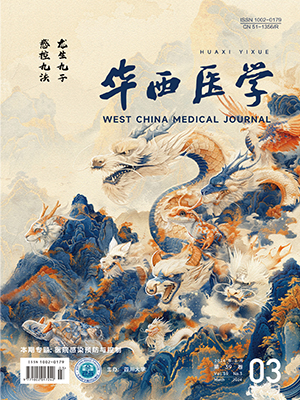| 1. |
Zuo Q, Yang P, Lv N, et al. Safety of coiling with stent placement for the treatment of ruptured wide-necked intracranial aneurysms: a contemporary cohort study in a high-volume center after improvement of skills and strategy. J Neurosurg, 2018, 131(2): 435-441.
|
| 2. |
唐海双, 贺晓武, 左乔, 等. 支架辅助弹簧圈栓塞治疗急性期颅内破裂动脉瘤的围手术期危险因素分析. 第二军医大学学报, 2019, 40(2): 117-124.
|
| 3. |
李航, 白卫星, 贺迎坤, 等. PipelineTM栓塞装置治疗颅内动脉瘤术后并发症研究进展. 介入放射学杂志, 2017, 26(8): 760-764.
|
| 4. |
Su W, Zhang Y, Chen J, et al. 225 intracranial aneurysms treated with the low-profile visualized intraluminal support (LVIS) stent: a single-center retrospective study. Neurol Res, 2018, 40(6): 445-451.
|
| 5. |
Wallace AN, Grossberg JA, Almandoz J, et al. Endovascular treatment of posterior cerebral artery aneurysms with flow diversion: case series and systematic review. Neurosurgery, 2018, 83(4): 790-799.
|
| 6. |
Tokunaga K, Hatano T, Nakahara I, et al. Factors associated with postprocedural diffusion-weighted imaging-positive lesions in endovascular treatment for unruptured cerebral aneurysms. World Neurosurg, 2019, 130: e457-e462.
|
| 7. |
杨忠庆, 朴金伟, 张卫东. 颅内动脉瘤介入术后脑缺血并发症的相关因素分析. 国际神经病学神经外科学杂志, 2020, 47(1): 14-17.
|
| 8. |
Kang HS, Han MH, Kwon BJ, et al. Is clopidogrel premedication useful to reduce thromboembolic events during coil embolization for unruptured intracranial aneurysms?. Neurosurgery, 2010, 67(5): 1371-1376.
|
| 9. |
Kocur D, Paździora P, Przybyłko N, et al. Thromboembolism during coiling of intracranial aneurysms: predictors and clinical outcome. Wideochir Inne Tech Maloinwazyjne, 2020, 15(2): 319-328.
|
| 10. |
Nagahata M, Kondo R, Saito S, et al. Which factors increase procedural thromboembolic events in patients with unruptured paraclinoid internal carotid artery aneurysm treated by coil embolization?. Neuroradiol J, 2011, 24(5): 712-714.
|
| 11. |
中华医学会神经病学分会脑血管病学组缺血性脑血管病血管内介入诊疗指南撰写组. 中国缺血性脑血管病血管内介入诊疗指南. 中华神经科杂志, 2011, 44(12): 863-869.
|
| 12. |
Song J, Kim BS, Shin YS. Treatment outcomes of unruptured intracranial aneurysm; experience of 1, 231 consecutive aneurysms. Acta Neurochir (Wien), 2015, 157(8): 1303-1310.
|
| 13. |
Ji W, Liu A, Lv X, et al. Risk score for neurological complications after endovascular treatment of unruptured intracranial aneurysms. Stroke, 2016, 47(4): 971-978.
|
| 14. |
Shimizu K, Imamura H, Mineharu Y, et al. Endovascular treatment of unruptured paraclinoid aneurysms: single-center experience with 400 cases and literature review. AJNR Am J Neuroradiol, 2016, 37(4): 679-685.
|
| 15. |
李力, 吕楠, 赵瑞, 等. 颅内未破裂动脉瘤血管内介入治疗程序相关性缺血性并发症的危险因素及临床特点分析. 第二军医大学学报, 2018, 39(1): 50-56.
|
| 16. |
顾大群, 张扬, 晁迎九, 等. 颅内破裂动脉瘤栓塞治疗并发血栓事件的危险因素分析. 中国神经精神疾病杂志, 2014, 40(11): 697-701.
|
| 17. |
Hahnemann ML, Ringelstein A, Sandalcioglu IE, et al. Silent embolism after stent-assisted coiling of cerebral aneurysms: diffusion-weighted MRI study of 75 cases. J Neurointerv Surg, 2014, 6(6): 461-465.
|
| 18. |
Lee SH, Jang MU, Kang J, et al. Impact of reducing the procedure time on thromboembolism after coil embolization of cerebral aneurysms. Front Neurol, 2018, 9: 1125.
|
| 19. |
夏鹏飞, 王伟, 高旭婷, 等. 颅内未破裂动脉瘤介入术后脑缺血性损伤的危险因素分析. 重庆医科大学学报, 2018, 43(2): 202-205.
|
| 20. |
Jo KI, Yeon JY, Kim KH, et al. Predictors of thromboembolism during coil embolization in patients with unruptured intracranial aneurysm. Acta Neurochir (Wien), 2013, 155(6): 1101-1106.
|




